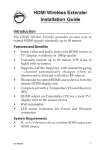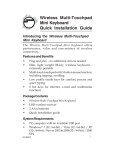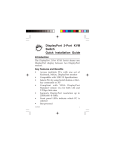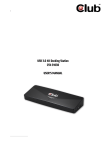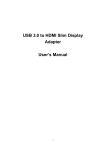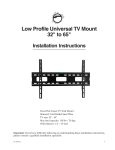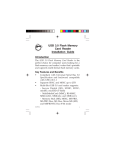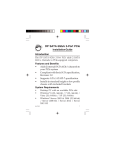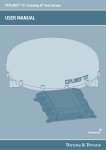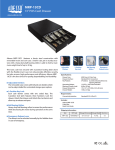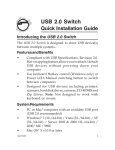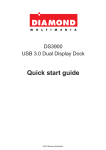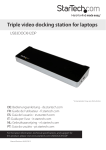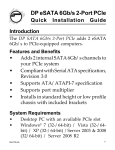Download USB 3.0 Dual Head Docking Station
Transcript
USB 3.0 Dual Head Docking Station Quick Installation Guide Introduction The USB 3.0 Dual Head Docking Station is a unique design for a computer that has extra connectivity demands. Features and Benefits • • • • • Adds dual displays, Gigabit, audio out, MIC in, and 6 USB 3.0/2.0 to your USB 3.0 enabled system Video outputs: HDMI and DVI supporting 1080p and up to 2048 x 1152 resolution Gigabit port compatible with IEEE 802.3 Compatible with SuperSpeed USB 3.0 and backwards compatible with USB 2.0 specification Audio out to support 2.1 & virtual 5.1 channel sound & a MIC jack System Requirements • • Dual core CPU at 2.0 GHz or higher processor clock with an USB 3.0 port available Windows® 7 (32-/64-bit) / Vista (32-/64-bit) / XP (32-bit) Package contents • • • • USB 3.0 Dual Head Docking Station Power Adapter USB 3.0 cable & software CD Quick installation guide 04-0800A 1 Layout Front side Rear side Figure 1: Layout 1. 2. Power indicator: Lights up when the power is on. USB indicator: Lights up when a USB device is plugged into this unit. 3. USB 3.0 ports: Connect to USB 3.0 devices. 4. Speaker jack: Connect to a speaker or earphone. 5. MIC jack: Connect to a microphone. 6. USB 2.0 ports: Connect to USB 2.0 devices. 7. RJ45 port: Connect to an Ethernet. 8. DVI connector: Connect to a DVI monitor or projector. 9. HDMI connector: Connect to a HDMI monitor or projector. 10. USB 3.0 port (Type B): Connect to a computer. 11. Power jack: Connect to the power adapter. 2 Application To connect the USB peripherals, Ethernet, speaker and microphone, follow the illustrations below to connect the corresponding connectors. Figure2: Connections Driver Installation Caution: DO NOT connect the docking station to the computer before installing the provided driver. Note that the following strings and screen shots shown on this user's manual may vary slightly from each operation. Windows 7 (32-/64-bit) / Vista (32-/64bit) 1. 2. 3. Insert the driver CD into the CD/DVD-ROM. At the CD AutoPlay box, click Open folder to view files. Double click Setup, then For Windows Vista: Click Allow to continue. For Windows 7: Click Yes to continue. 3 Note: If the AutoPlay does not appear automatically, locate and double-click on the Setup.exe file in the driver CD to launch the setup. Enter the administrator password and then click Yes to start the installation if a User Account Control dialog box appears. 4. 5. 6. 7. Click I Accept for the next step. Be patient with the DisplayLink installation procedure, it may take a while. Do not interrupt the installation process. Connect theUSB 3.0 Dual Head Docking Station to a computer after the driver installation is completed. For connection details, refer to the figure in Layout on page 2. When the operating system detects the adapter, the reminder message will appear on the system tray. Windows XP(32-bit) 1. 2. Insert the driver CD into the CD/DVD-ROM. Click Star, Run, type D:\setup.exe, then click OK. (Change D: to match your CD/DVD-ROM driver letter) 3. 4. 5. 6. 7. 4 Click I Accept for the next step. Be patient with the installation procedure, it may take a while. Follow the on screen instructions to compete the installation. Click Yes to restart or No to manually restart later, if a prompting to restart computer message appears. Connect the USB 3.0 Dual Head Docking Station to a computer after the driver installation is completed. For connection details, refer to page 2 & 3. To Verifying Windows Installation 1. 2. Check in Device Manager to verify installation. For Windows 7: Right click Computer, click Manager, then click Device Manager. For Windows Vista: Right click Computer, click Manager, click Continue, then click Device Manager. For Windows XP: Right click My Computer, click Manager, click Device Manager. A string similar to DisplayLink.. Adapter device should be listed. Note: If there is a (yellow question mark) or (exclamation mark) next to that item, then the driver is not properly installed. In this case, please delete the item, unplug the adapter and repeat the driver installation steps Display Configuration Note that the following screen shots in this section are using Windows 7 operating system. It may not match your operating system but the definitions of buttons, tabs and menus are the same. Utility Settings The supplied utility allows configuring the display mode, screen rotation, screen resolution, and physical arrangement of your monitors. 1. Click (utility icon) in the Windows System Tray. Note: The may be hiddden in the Windows System Tray. Click (arrow icon) to bring up more icons if this happens. 2. Select a preferred option, and then click it. 5 Figure 3: Utility Setting Description of the Settings • DisplayLink Manager: Enable the Windows screen resolution page • Check for Updates: Check for the latest driver and download if available USB 3.0 Dual Video Adapter: • Screen Resolution: Click to select an available resolution. Note that this function is invalid in mirror mode, as the resolution is defined by the resolution of the primary monitor • Screen Rotation: Rotate the screen according to the desired orientation • Extend To: Extend the screen according to the desired orientation • Set as Main Monitor: Set this screen to the main screen • Mirror: Duplicate the primary monitor to the monitor which connects with the adapter • Off: Turn off the monitor • Optimize for Video: Optimize the video quality when playing back. Text may appear less clear when enabling. 6 • • • Fit to TV: Adjust the size of Windows Desktop on the TV. Note: This function works only when one addon monitor is connected Audio Setup: Enable the Windows audio configuration page. This function works only in specific models Video Setup: Enable the Windows screen resolution Multi-Monitor Configuration The additional DVI/HDMI monitors can be configured to either mirror mode, extended mode or be the primary display. Position the mouse anywhere on the Windows Desktop, For Windows 7: Right click then select Screen Resolution. For Windows Vista: Right click then select Personalize then click Display Settings. For Windows XP: Right click then select Properties Settings. Alternatively, click (utility icon) in the Windows System Tray, and then select DisplayLink Manager or Video Setup. Figure 4: Monitor Orientation 7 Extended Mode 1. 2. 3. 4. 5. Refer to the Multi-Monitor Configuration on page 7 to open the configuration page. In the Display drop-down menu, select the preferred monitor. Check the Multiple displays. For Windows 7: Extend desktop to this display For Windows Vista: Extend the desktop onto this monitor box. For Windows XP: Extend my Windows desktop onto this monitor box. Click OK to confirm and close the settings screen. Once the setting is completed, simply drag and drop the application icons or the opened windows, in restore down mode, to the add-on monitor. However, some applications may not support to display on the extended desktop. Cursor Disappearing In some cases, when removing the adapter while in extended mode, the desktop will still be paired to the add-on monitor(s) and the mouse cursor may not return to the primary monitor. If this happens, connect the addon monitor(s) and adapter again or keep moving the mouse. Video Playback in Extended Mode If the video or DVD playback quality is poor or low performance in the extended mode, please playback on the primary monitor instead of the add-on monitor(s). 8 Mirror Mode 1. Refer to the Multi-Monitor Configuration on page 7 to open the configuration page. In the Display drop-down menu, select the preferred monitor. Check the Multiple displays Windows 7: Duplicate desktop on X and X. Windows Vista: Uncheck the Extend the desktop onto this monitor box. Windows XP: Uncheck the Extend my Windows desktop onto this monitor box. Click OK to confirm and close the settings screen. 2. 3. 4. Primary Monitor 1. 2. 3. Refer to the Multi-Monitor Configuration on page 7 to open the configuration page. In the Display drop-down menu, select the preferred monitor. Check the Make this my main display box on Window 7 /Windows Vista or Use this device as the primary monitor box on Windows XP. Note: Video playback in mirror mode is not recommended under Windows XP system or in Basic mode under Windows Vista & Windows 7 system. 4. Click OK to confirm and close the settings screen. Windows Shortcut Press Windows key + P button to bring up the menu as below, and then select a desired option. This function is available for Windows 7 only. 9 Figure 5: Windows shortcut Note: Some PCs and laptops may need to disable the main display (i.e. uncheck the Extend the desktop onto this monitor or Extend my Windows desktop onto this monitor box for the main display) as part of the same settings change. Uninstalling the Driver For Windows 7 (32-/64-bit) 1. 2. 3. Open the Control Panel > Programs > Programs and Features > Uninstall or change a program, and then double click DisplayLink Graphics. Click Yes to continue the procedure. Click Yes to restart your computer. For Windows Vista (32-/64-bit) 1. 2. 3. Open the Control Panel > Programs > Programs and Features > Uninstall or change a program, and then double click DisplayLink Graphics. Click Yes to continue the procedure. Click Yes to restart your computer. For Windows XP (32-bit) 1. 2. 3. 10 Open the Control Panel >Add or Remove Program > then click DisplayLink Graphics and Remove. Click Yes to continue the procedure. Click Yes to restart your computer. Technical Support and Warranty QUESTIONS? SIIG’s Online Support has answers! Simply visit our web site at www.siig.com and click Support. Our online support database is updated daily with new drivers and solutions. Answers to your questions could be just a few clicks away. You can also submit questions online and a technical support analyst will promptly respond. SIIG offers a 3-year manufacturer warranty with this product. This warranty covers the original purchaser and guarantees the product to be free of any defects in materials or workmanship for three (3) years from the date of purchase of the product. SIIG will, at our discretion, repair or replace (with an identical product or product having similar features and functionality) the product if defective in materials or workmanship. This warranty gives you specific legal rights, and you may also have other rights which vary from state to state. Please see our web site for more warranty details. If you encounter any problems with this product, please follow the procedures below. A) If it is within the store's return policy period, please return the product to the store where you purchased it. B) If your purchase has passed the store's return policy period, please follow these steps to have the product repaired or replaced. Step 1: Submit your RMA request. Go to www.siig.com, click Support, then Request A Product Replacement to submit a request to SIIG RMA or fax a request to 510-657-5962. Your RMA request will be processed, if the product is determined to be defective, an RMA number will be issued. Step 2: After obtaining an RMA number, ship the product. • Properly pack the product for shipping. All software, cable(s) and any other accessories that came with the original package must be included. • Clearly write your RMA number on the top of the returned package. SIIG will refuse to accept any shipping package, and will not be responsible for a product returned without an RMA number posted on the outside of the shipping carton. • You are responsible for the cost of shipping to SIIG. Ship the product to the following address: SIIG, Inc. 6078 Stewart Avenue Fremont, CA 94538-3152, USA RMA #: • SIIG will ship the repaired or replaced product via Ground in the U.S. and International Economy outside of the U.S. at no cost to the customer. 11 About SIIG, Inc. Founded in 1985, SIIG, Inc. is a leading manufacturer of IT connectivity solutions (including Serial ATA and Ultra ATA Controllers, FireWire, USB, and legacy I/O adapters) that bridge the connection between Desktop/ Notebook systems and external peripherals. SIIG continues to grow by adding A/V and Digital Signage connectivity solutions to our extensive portfolio. All centered around the distribution and switching of A/V signals over CAT5/6, these products include matrix switches, distribution amplifiers, extenders, converters, splitters, cabling, and more. SIIG is the premier one-stop source of upgrades and is committed to providing high quality products while keeping economical and competitive prices. High-quality control standards are evident by one of the lowest defective return rates in the industry. Our products offer comprehensive user manuals, user-friendly features, and most products are backed by a lifetime warranty. SIIG products can be found in many computer retail stores, mail order catalogs, and e-commerce sites in the Americas, as well as through major distributors, system integrators, and VARs. PRODUCT NAME USB 3.0 Dual Head Docking Station FCC RULES: TESTED TO COMPLY WITH FCC PART 15, CLASS B OPERATING ENVIRONMENT: FOR HOME OR OFFICE USE FCC COMPLIANCE STATEMENT: This device complies with part 15 of the FCC Rules. Operation is subject to the following two conditions: (1) This device may not cause harmful interference, and (2) this device must accept any interference received, including interference that may cause undesired operation. THE PARTY RESPONSIBLE FOR PRODUCT COMPLIANCE SIIG, Inc. 6078 Stewart Avenue Fremont, CA 94538-3152, USA Phone: 510-657-8688 USB 3.0 Dual Head Docking Station is a trademark of SIIG, Inc. SIIG and the SIIG logo are registered trademarks of SIIG, Inc. Microsoft and Windows are registered trademarks of Microsoft Corporation. All other names used in this publication are for identification only and may be trademarks of their respective owners. May, 2012 Copyright © 2012 by SIIG, Inc. All rights reserved.














